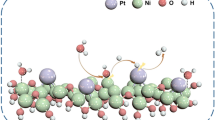Abstract
Using first-principles calculations, this paper reports a systematic research on HER performance enhancing of LNS-TiO2 by passivated codoping. Six codoping systems, Ti17O35CrC, Ti17O35MoC, Ti17O35WC, Ti17O35VN, Ti17O35NbN and Ti17O35TaN are studied. Results show that the energy band can be tuned by the codoping donor–acceptor pairs. The energy band performance of Ti17O35WC should be the best in HER process for its tiny CBM change and small band gap. Besides, the hydrogen adsorption ability of LNS-TiO2 in HER process can also be tuned by the codoping pairs. The hydrogen adsorption performance of Ti17O35TaN should be the best for its ∆GH* is close to zero. In a word, Ti17O35WC and Ti17O35TaN have their own advantages as catalysts in HER process, and their exact HER efficiency is waiting to be obtained in the future experiments. In general, this passivated codoping LNS-TiO2 represents a novel kind of material. Research in this paper can enrich the theoretical knowledge of HER field.
Graphical Abstract




Similar content being viewed by others
References
Lewis NS, Nocera DG (2006) Powering the planet: chemical challenges in solar energy utilization. Proc Natl Acad Sci 103:15729–15735
Dresselhaus MS, Thomas IL (2001) Alternative energy technologies. Nature 414:332–337
Lu S, Yang S, Hu X, Liang Z, Guo Y, Xue Y, Cui H, Tian J (2019) Fabrication of TiO2 nanoflowers with bronze (TiO2(B))/ anatase heterophase junctions for efficient photocatalytic hydrogen production. Int J Hydrogen Energy 44:24398–24406
Shi J, Ji Q, Liu Z, Zhang Y (2016) Recent advances in controlling syntheses and energy related applications of MX2 and MX2/ graphene heterostructures. Adv Energy Mater 6:1600459
Zhang W, Zhu S, Luque R, Han S, Hu L, Xu G (2016) Recent development of carbon electrode materials and their bioanalytical and environmental applications. Chem Soc Rev 45:715–752
Chen D, Chen W, Ma L, Ji G, Chang K, Lee JY (2014) Graphene-like layered metal dichalcogenide/graphene composites: synthesis and applications in energy storage and conversion. Mater Today 17:184–193
Fujishima A, Honda K (1972) Electrochemical photolysis of water at a semiconductor electrode. Nature 238:37–38
Eivari HA, Ghasemi SA, Tahmasbi H, Rostami S, Faraji S, Rasoulkhani R, Goedecker S, Amsler M (2017) Two-dimensional hexagonal sheet of TiO2. Chem Mater 29:8594–8603
Zhou W, Umezawa N, Ma R, Sakai N, Ebina Y, Sano K, Liu M, Ishida Y, Aida T, Sasaki T (2018) Spontaneous direct band gap, high hole mobility, and huge exciton energy in atomic-thin TiO2 nanosheet. Chem Mater 30:6449–6457
Sakai N, Ebina Y, Takada K, Sasaki T (2004) Electronic band structure of titania semiconductor nanosheets revealed by electrochemical and photoelectrochemical studies. J Am Chem Soc 126:5851–5858
Yuan J, Wang C, Liu Y, Wu P, Zhou W (2018) Tunable photocatalytic HER activity of single-layered TiO2 nanosheets with transition-metal doping and biaxial strain. J Phys Chem C 123:526–533
Ida S, Kim N, Ertekin E, Takenaka S, Ishihara T (2015) Photocatalytic reaction centers in two-dimensional titanium oxide crystals. J Am Chem Soc 137:239–244
Yuan J, Liu Y, Bo T, Zhou W (2020) Activated HER performance of defected single layered TiO2 nanosheet via transition metal doping. Int J Hydrogen Energy 45:2681–2688
Gai Y, Li J, Li S, Xia J, Wei S (2009) Design of narrow-gap TiO2: a passivated codoping approach for enhanced photoelectrochemical activity. Phys Rev Lett 102:036402
Ahn KS, Yan Y, Shet S, Deutsch T, Turner J, Al-Jassim M (2007) Enhanced photoelectrochemical responses of ZnO films through Ga and N codoping. Appl Phys Lett 91:231909
Huda MN, Yan Y, Wei SH, Al-Jassim M (2008) Electronic structure of ZnO:GaN compounds: asymmetric bandgap engineering. Phys Rev B 78:195204
Kresse G, Furthmller J (1996) Efficient iterative schemes for ab initio total-energy calculations using a plane-wave basis set. Phys Rev B: Condens Matter Mater Phys 54:11169–11186
Perdew JP, Burke K, Ernzerhof M (1996) Generalized gradient approximation made simple. Phys Rev Lett 77:3865–3868
Blöchl PE (1994) Projector augmented-wave method. Phys Rev B: Condens Matter Mater Phys 50:17953–17979
Kresse G, Joubert D (1999) From ultrasoft pseudopotentials to the projector augmented-wave method. Phys Rev B: Condens Matter Mater Phys 59:1758–1775
Yin W, Tang H, Wei S, Al-Jassim MM, Turner J, Yan Y (2010) Band structure engineering of semiconductors for enhanced photoelectrochemical water splitting: the case of TiO2. Phys Rev B 82:045106
Tang Q, Jiang D (2016) Mechanism of hydrogen evolution reaction on 1T-MoS2 from first principles. ACS Catal 6:4953–4961
Li J, Wei SH, Li SS, Xia JB (2006) Design of shallow acceptors in ZnO: First-principles band-structure calculations. Phys Rev B 74:081201
Acknowledgements
This paper is supported by the National Natural Science Foundation of China under Grant No. 11804082, 21905215, 11975173, 12035006 and Educational Commission of Hubei Province of China under Grant No. 2020CFB127. And the numerical calculation is supported by High-Performance Computing Center of Wuhan University of Science and Technology.
Author information
Authors and Affiliations
Corresponding author
Additional information
Publisher's Note
Springer Nature remains neutral with regard to jurisdictional claims in published maps and institutional affiliations.
Rights and permissions
About this article
Cite this article
Dai, H., Wang, C., Cai, X. et al. First-Principles Calculations on the HER Performance of TiO2 Nanosheet with Passivated Codoping. Catal Lett 153, 1278–1283 (2023). https://doi.org/10.1007/s10562-022-04080-6
Received:
Accepted:
Published:
Issue Date:
DOI: https://doi.org/10.1007/s10562-022-04080-6




